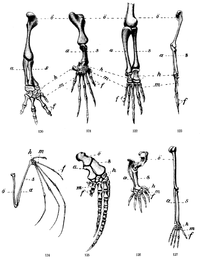Paleontology/Anatomy
Until this has been developed, please see Anatomy/Introduction.
This page will discuss how species are fossilized and the most common anatomical structure to be fossilized. There will be links to the structure of the various Kingdoms if the fossil record.
In the study of palaeontology the analysis of a fossil will depend on its preservation detail and anatomical structure. For soft bodied invertebrates the analysis is mainly of impression left in rock, most likely the impression is a cast of the outer anatomy with specially preserved specimen fossils containing traces of their internal structure. The same can not be said for vertebrates, where the main structure preserved are the skeletal structure. In this instance the case for the soft tissue of a vertebrate is only preserves as impressions and in a few cases like the w:Thylacine and w:Woolly Mammoth, where the former were mummified in a dry habitat and the later in Arctic tundra.
Taxonomy
[edit | edit source]The study of w:Taxonomy is the relationships of all life in how they are related to each other.
Bacteria
[edit | edit source]See w:Bacteria
Bacterial fossil structure and preservation

Bacteria have left a fossil record dating back to the Precambrian era 3,500 million , they are w:Cyanobacteria and are mainly fossilized in w:chert and sometimes in w:shale[1]. Being small, bacteria are only identifiable if a palaeontologist seeks to deliberately find a specimen. Loren Babcock (et el.) has described 180 million year old fossil bacteria similar to w:eubacteria from Antarctica, that have collonised inside a deceased bivalve; w:Lioestheria disgregaris. There they dissolved the calcium and replaced the specimen with themselves but keeping the structure of the arthropod. The bacteria in tern absorbed silica from the surounding rock and were self fossilized in the process. Babcock (et el.) in a nearby area called Carapace Nunatakthey found fossilized w:archaebacteria inside limestone deposits of a uncertain age and also including Cyanobacteria. Studies on the genetics of archaebacteria suggest they have existed for about 2 billion years, and possibly were the first life to evolve. But archaebacteria are also rarely preserved as fossils.[2].
Cynobacteria have a thick cell wall which would help in their preservation, and can form w:stromatolites or w:oncolites. Other bacteria can be replaced by minerals such as w:pyrite or w:siderite, forming w:pseudomorphs or replicas of the once-living cells, giving a representation of the cell structure in real life. Trace fossils may be formed from "bacteria secrete iron-coated sheaths and other bacteria may bore into shells or rocks and form microscopic canals within the shell" these fossil bacteria are referred to as endolithic. Bacteria can be found in w:Ambersuch as in Ellsworth County, Kansas, either from the Kiowa Shale, Albian of the Early Cretaceous or Terra Cotta Clay of the Dakota Group, Cenomanian from the Late Cretaceous, where sheathed bacteria related to the genus Leptothrix[3]. Fossilized bacteria has also been found in animal tissue (either desicated or frozen). Magnetobacteria have iron oxide crystals in their cells that are left as trace fossils after death[4].
Plants
[edit | edit source]Algae fossil structure and preservation Plant fossil structure and preservation
Invertebrates
[edit | edit source]
A good place to start about early species would be the w:Ediacara biota. These were the first multicellular organisms to be fossilized. Their taxonomy is vague as most dont bear much connection to modern phyla.
These include w:multicellular animals with and without an w:exoskeleton.
Vertebrates
[edit | edit source]Vertebrate fossil structure and preservation

The vertebrates are distinguished in having a w:backbones or w:spinal columns. A slightly higher though unranked clad is the w:Craniata which includes w:Myxini or the hagfish and w:Cephalaspidomorphi or w:jawless fish.
w:Fish anatomy, w:Frog anatomy, w:Bird anatomy, w:Reptile anatomy, w:Mammal anatomy.
References
[edit | edit source]- ↑ http://www.ucmp.berkeley.edu/bacteria/cyanofr.html Cyanobacteria: Fossil Record from Berkeley University
- ↑ http://www.spacedaily.com/news/life-04zzzzo.html Ancient Creature Fossilized By The Bacteria That Ate It Denver CO (SPX) Nov 11, 2004
- ↑ http://www.ucmp.berkeley.edu/museum/171online/PB171BMWPG1.html Bacteria and protists from Middle Cretaceous amber of Ellsworth County, Kansas by Benjamin M. Waggoner Department of Integrative Biology, University of California, Berkeley, CA 94720
- ↑ http://www.ucmp.berkeley.edu/bacteria/bacteriafr.html Berkeley University
